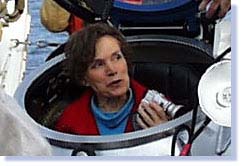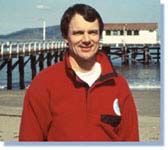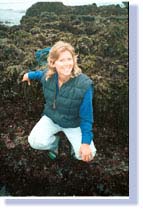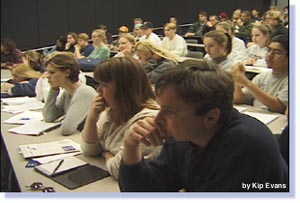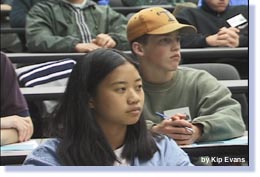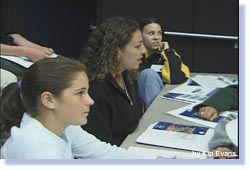|
Sanctuary
Summits - Cordell Bank
General
Information
About
the Panel of Experts
References
Post-Summit
Summary
Student
Projects
General
Information
Date:
April 26, 1999
Location: Bodega Marine Laboratory
Participants: Science classes from the
Sonoma County area
Theme: Exploration in Cordell
Bank
High school
science classes from the Sonoma County area will
participate in a Sustainable Seas Expedition
Sanctuary Summit on April 26, 1999 at the Bodega
Marine Laboratory.
Panel
experts:
- •Dr.
Sylvia Earle, Explorer-in-Residence, National
Geographic Society
•Ed Ueber, Gulf of the Farallones &
Cordell Bank Sanctuary Manager
•Dan Howard, Cordell Bank National Marine
Sanctuary Assistant Manager
•Kathy Soave, 1999 Bay Area
Teacher-at-Sea
•Tom Laidig, Sustainable Seas Expeditions
researcher and aquanaut.
Following an
introduction by Dr. Earle, there will be a slide
show about Cordell Bank National Marine Sanctuary
and statements from panel members regarding their
roles in the project. Then Dr. Earle will divide
students into smaller focus groups. Using the
information and details covered during the
presentations, as well as the supplemental material
they will receive on arrival, the student focus
groups will be charged with designing and
developing an original research proposal. A student
proposal may be selected and incorporated into the
following years of Sustainable Seas Expeditions in
Cordell Bank National Marine Sanctuary. A
high-school class may be part of the research team
for the year 2000!
(top)
About the Panel of
Experts
Sylvia
Earle
National Geographic Society
Marine biologist Sylvia Earle
is Explorer-in-Residence at the National Geographic
Society, a position she has held since 1998. She is
working with a variety of Society divisions on
projects involving her passion -oceans - especially
serving as project director of Sustainable Seas
Expeditions and writing three books for publication
in 1999.
Named one of Time Magazine's
"heroes for the planet" in 1998, Earle has
pioneered research on marine ecosystems and has led
more than 50 expeditions totaling 6,000 hours
underwater. She holds numerous diving records and
is the author of more than 100 scientific and
popular publications, including a 1995 book "Sea
Change."
Earle was born August 30,
1935, in Gibbstown, NJ. She has a bachelor's degree
from Florida State University and a master's and
doctorate from Duke University, as well as nine
honorary doctorate degrees. She lives in Oakland,
California.
Ed Ueber
Gulf of the Farallones National Marine
Sanctuary
Ed Ueber is the manager of
Cordell Bank and Gulf of the Farallones National
Marine Sanctuaries, and co-manager of the northern
portion of the Monterey Bay National Marine
Sanctuary. Mr. Ueber oversees all administrative,
research, education, and enforcement programs that
occur within the sanctuary boundaries. He is also
the Department of Commerce trustee for the Apex
Houston and Cape Mohican oil spill settlements.
Prior to becoming sanctuary manager, Mr. Ueber
conducted fisheries research. He has published
peer-reviewed papers on fish biology, fishing
techniques, global warming, fishery economics, fish
trade, fishery management, wooden boat building,
wooden ship construction, oceanography and marine
operations.
Dan Howard
Cordell Bank National Marine Sanctuary
Dan Howard is the assistant
manager of Cordell Bank National Marine Sanctuary.
He is currently involved in education, research and
management activities associated with Cordell Bank
and Gulf of the Farallones National Marine
Sanctuaries. Since 1980, he has been studying
nearshore ecology of cold temperate, warm
temperate, and tropical marine environments. He has
completed over 2000 dives investigating nearshore
reef communities in California and Hawaii and
participated in a series of oceanographic research
cruises over California's continental shelf. Much
of this work investigated relationships between
fish predators and their prey. He has published on
a variety of subjects relating to his research.
Topics range from natural mortality rates for first
year juvenile rockfish to the effects of Hurricane
Iniki on deep water corals in Hawaii. During the
Sustainable Seas Expeditions, Mr. Howard will be
using DeepWorker to investigate deep water habitats
at Cordell Bank. Visual and video transects will be
used to characterize habitats and assess algae,
invertebrate and fish populations around the
Bank.
Kathy Soave
Teacher at Sea
Kathy Soave was chosen to be Cordell Bank and Gulf
of the Farallones "Teacher at Sea." Kathy will
observe the dive operations, participate in
sanctuary research, and interact with the
scientists and educators onboard the NOAA ship
McArthur. Kathy is a science teacher at the Branson
School located in Ross, California. She currently
teaches Marine Biology, Honors Chemistry and
Environmental Science. In addition to designing and
building the Marine Biology curriculum at Branson,
she uses local field sites for her students to
investigate varying ocean habitats, has created an
immensely popular marine biology "mini-seminar "
for Parents' Day, and organized an all-school,
all-day assembly around the topic of the marine
environment. At her school, she has won two
prestigious awards as an outstanding faculty
member/teacher and has been Junior Class Dean for
three years.
Her leadership roles in
education have included being a Master and Mentor
Teacher as well as being involved with the
Expanding Your Horizons workshops to foster
middle/high school girls interest in math and
science. Kathy is also an avid diver and has
considerable skills in marine photography.
(top)
References
Ecology of an Underwater
Island by Robert W. Schmieder
The book is a summary of what is known about the
ecology of Cordell Bank. It is based on a series of
exploratory expeditions led by the author and
colleagues. The book summarizes the physical
factors that appear important to the biotic
community living on Cordell Bank, and how the
community interacts with itself and its
surroundings.
Cordell Bank Fact
Sheet.
This is an educational fact sheet on the unique
features of Cordell Bank.
Post-Summit
Summary
Overview
|
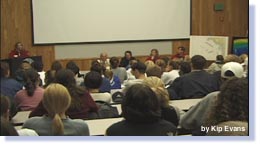
|
|
Maria
Brown welcomes the nearly 100 high school
students from The Branson School,
Cloverdale, El Molino, and Tomales High
Schools to the Sanctuary
Summit.
|
The first
Student Summit of the Sustainable Seas Expeditions
took place in the auditorium of the Bodega Marine
Laboratory, directly inland from Cordell Bank
National Marine Sanctuary. Nearly 100 high school
students from Sonoma County traveled to the site to
participate in the discussions of the day.
Attendees included students from The Branson
School, Cloverdale, El Molino, and Tomales High
Schools, and their teachers.
|
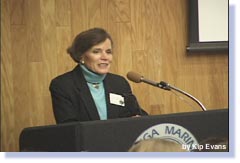
|
|
Dr. Sylvia
Earle familiarized the students at the
summit with the mission of the Sustainable
Seas Expeditions.
|
The audience
was welcomed by Maria Brown, Executive Director of
the Farallones Marine Sanctuary Association and
organizer of the event. Dr. Sylvia Earle, National
Geographic's Explorer-in-Residence and the Chief
Scientist for the Sustainable Seas Expeditions,
then spoke to the students and showed them a brief
video to better familiarize them with the mission
of this unique project. Dan Howard, Assistant
Manager for Cordell Bank National Marine Sanctuary,
presented a slide show on the resources of the
Sanctuary, as well as the challenges of accessing
it, and how the DeepWorker technology offers many
opprotunities for further research and exploration.
Presentations from Ed Ueber (Sanctuary Manager),
Kathy Soave (Teacher at Sea), and Tom Laidig
(National Marine Fisheries Service biologist and
pilot of the DeepWorker) concluded the students'
orientation to the project at hand.
|
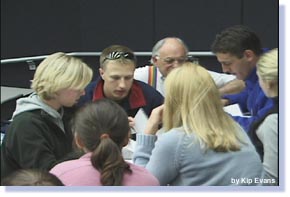
|
|
Students
work in small groups to formalize ideas
for ocean exploration at Cordell
Bank.
|
After hearing
from the panel members, the students were given
their assignment to design a research project and
were divided into smaller groups. These groups were
guided by submersible pilots for the Gulf of the
Farallones and Cordell Bank National Marine
Sanctuaries' Expeditions. For the next hour the
students unleashed their ideas and explored the
range of future possibilities for the DeepWorker.
(top)
Project
Ideas
The students
came up with the following concepts for exploration
at Cordell Bank:
1.) "Current
Effects on Sessile Marine Organisms"--researching
the relationship between the currents and seasonal
upwelling on the location, population size, and
density of the strawberry anemone in the Cordell
Bank area. (The Branson School)
2.) "Diurnal
and Vertical Biogeography of Cordell
Bank"--analyzing vertical migratory and behavior
patterns in relationship to topography and
productivity. (The Branson School)
3.)
"Establishing a Health Rating for the
Bank"--surveying diversity and abundance of species
over a four year period in order to establish
comparable results over the next seven years. (El
Molino High School)
4.) "Fossils
Are Our Friends"--investigating the number and type
of fossils left in the sediment of Cordell Bank in
order to determine its origin. (Tomales High
School)
5.) "Don't
Destroy It Before You Explore It: Human Effects on
the Ocean"--taking the sub down to all possible
areas to show what is there and what has been
negatively affected by us. Educate the public
through multimedia presentations and the web.
(Cloverdale High School)
6.)
"Exploration and Research Day and Night on Cordell
Bank"--observing changes in the daily location and
abundance of krill, and how this affects the food
chain. (Cloverdale High School)
|
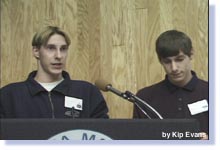
|
|
Students
present their concepts for future
expeditions to the assembly.
|
An elected
student from each of the six groups presented the
concept of their project to the assembly and how it
would further the missions of the SSE. Closing
remarks from Maria Brown complemented the students
on their ingenuity, as did Sylvia Earle who saw
great hope for changes to be made in the future by
these talented young people.
(top)
Quotes
Students
"You've got to
study the whole system in order to really
understand what's going on out there. Everything is
part of something bigger and affects everything
else. That's why we propose doing a biogeography
study--putting together all the pieces for a
complete picture." --Lauren
Morlock
"We think
education is really where it's at. People have to
know what's out there in order to want to protect
it and with all the possibilities in the field of
multimedia, we can reach people as far inland as
Kansas and bring the ocean to them."
--Jason
and Kyle Siebenthall
"The only
thing missing from this day is that you should let
the students pilot the DeepWorkers for a taste of
what it's really like."
--unanimous
Teachers
"I was
impressed with the interesting and thoughtful
research projects my students
developed."--Steve
Salkovics, Cloverdale High
School
"This has
been a great experience! I'm looking forward to
participating in SSE in the coming years of the
Expeditions. This is so important, bringing to the
public why we need to protect the oceans. We need
the oceans in order to survive, they don't need us.
We need to figure out what it's going to take to
make things
sustainable."--Kathy
Soave, The Branson School
Organizer
"I think the
day went really well. The students have great ideas
and it was inspiring to see them so fired up about
sanctuary research."
--Maria
Brown
Panel
Members
This Student
Summit was a chance for us to reenergize ourselves
with new ideas from younger people."
--Ed
Ueber
" It was
heartening to see a gathering of teenagers with
such great ideas and genuine concern for the health
of our marine environment, as opposed to the
negative image of teens usually portrayed in the
media."--Dan
Howard
(top)
Student
Projects
Project #1: A day &
night at Cordell Bank National Marine
Sanctuary
Project Duration:
October 1, 2000 to October 14, 2000
School: Cloverdale High School
Student Names: Jake B., Sophia D., Megan A.,
Kari M., Arthur C., Doug S., Josh S.
Teacher: Preston Addison
E-mail: addisonp@cusd.org
Project Abstract:
The team would observe marine life at Cordell Banks
during times of peak daylight and total darkness in
the mid water zone at specific depths and times.
The species of concentration would be krill because
they are most abundant and are more likely to
travel from the depths off the edge of the back to
the mid water zone. The deep worker would be used
to document the expedition on film and this footage
would later be made into an educational video
available for distribution around the country to
schools and other educational
institutions.
Project
Description:
Observe marine life during the day and during the
night. Samples would be taken at 150, 170, and 180
feet. Sample and counting times would be at 12:00
noon and 12:00 midnight. The specific species of
focus would be Krill from the continental shelf to
the mid water column. Focusing specifically on the
Abundance of Krill in a given depth during both day
and night. Equipment: plankton nets, submersible
"deep worker" with video cameras, night vision
system, limited light equipment, light meter,
collection bags. The team would watch krill in
density during the day and night hours. October
would be a good month because of optimum sea
conditions.
Project Requirements and
Restraints:
Being able to dive at night. Being able to do one
day dive and one day dive every day for two weeks
and find a pilot willing to do that. Being able to
film in low light. Being able to get into the water
on a daily basis.
Correlation with SSE
Goals:
The project supports the monitoring and education
goals because the information learned would be
documented and distributed to the public after
monitoring was completed.
Comments or Additional
Material:
The pilot of the deep worker could start very deep
and film the traveling marine life as they ascend
to the mid water column.
Project #2: Don't
Destroy It Before You Explore It": Human Effects on
the Ocean
School: Cloverdale
High School
Student Names: Shawna C., Heather C.,
Whitney C., Alan F., Ian J., Natasha L., Jason S.,
Kyle S.
Teachers: Preston Addison and Steve
Salkovics
Email: addiosnp@cusd.org
and salkovis@cusd.org
Abstract
Our project is titled "Don't Destroy It Before You
Explore It.": Human Effect on the Ocean. We would
use the Deep Worker submersibles to go down to all
possible areas in the Cordell Bank to show what is
there, what is affected, and what can be affected
by humans. We would then process our information,
and show it to our target audience: teens. Teens
are the future, and the choices they make now will
affect the oceans later. We would show them our
information through multimedia presentations and
virtual reality, which could be put on the
Internet. People need to see the variety of species
in the ocean, and those that have not been
discovered yet. But we shouldn't destroy it before
we explore it.
Project Description:
The goals of our project are to show the public
what is there at Cordell Bank, what has been
damaged by humans, and to tell them how to save
that which is left. We would study all the habitats
at Cordell Bank, and at different depths, as far
down as is allowed by the Deep Worker submersibles.
The equipment that we would need would be:
1. 2 Deep Worker 2000 submersibles
2. The McArthur ship
3. Camera equipment to be mounted on the Deep
Workers
4. Computers with enough power to put together
virtual maps
We would also need pilots to
operate the submersible, people to work the
computers to assemble the maps and multimedia
presentations, and one or two people for publicity.
One of the proposed research methods is to arrange
a grid over Cordell Bank, put the two submersibles
on opposite sides of the Bank, and work inward,
covering as much area as possible, documenting the
effects of humans on Cordell Bank.
The project would be divided
into four phases:
Phase I
During phase I of the project, we would conduct our
research. We would load up the McArthur at Bodega
Bay, and go out to Cordell Bank. We would use our
grid to position the two Deep Workers on opposite
sides of the Bank. We would try to do 4 dives a
day, two hours in length. We would document
everything we found down there, the diversity of
life, and the damage done by humans.
Phase II
During phase II of the project, we would process
all the data gathered in phase I. We would then
produce a video using film taken while down at the
Bank. Along with the video, we would produce a
multimedia presentation to be put up on the
Internet and shown at conferences and assemblies,
and we would produce virtual reality maps of the
Bank. To further get our message out, we would
distribute the video to TV stations, and to
teachers along with a lesson plan about Cordell
Bank and how humans are affecting the ocean through
pollution, and how to save that which is still
there. Because of the demands put on a computer to
display virtual reality, we would outfit a van with
the latest equipment available, and we would drive
it around the country to schools.
Phase III
As was mentioned by the pilots and others at the
summit, why would the person in Kansas care about
the ocean? "Out of sight, out of mind." We would
hold a nation-wide lottery for adults and students.
Those who won would get to go out for a day on the
McArthur. We would go down to Cordell Bank in the
Deep Workers, and use live video links to let those
on the sip see what was going on under the ship.
This would bring them closer to the whole project,
and hopefully impact how they feel about ocean
pollution.
Phase IV
During phase IV, we would follow up on all of our
research. We would try to see if anything had
changed. We would set up monitoring systems to
continually see what is going on at the
Bank.
During this project, we would
use all the technology available. But, because
technology is ever expanding, in the future more
advanced technology would become available, which
would allow us to go back to the bank, and go
deeper to see if humans can impact life further
down in the ocean.
Project Requirements and
Restraints:
For our project to be implemented, we would
need pilots, publicity directors, people to operate
the computers, and project directors. Some of the
restraints would be time, and the seasons
(condition of the sea).
We would use the 2
submersibles to dive about 4 times a day, at about
2 hours per dive. We don't know exactly how long
the project would take, but the majority of the
time would be spent analyzing the data
collected.
Correlation with SSE
Goals:
(I) Ocean Observatory and Monitoring Sites:
For follow up to our project, we would want to set
up monitoring stations at the Bank to see if the
condition of the Bank improves.
(II) Exploration:
We would be exploring the Bank during phase I of
the project. We would use the submersibles to not
only study the pollution at the Bank, but the
amount of life down there. After the project is
over, when new technology arises, we might be given
the chance to do more at the Bank, like go
deeper.
(III) Research on a Resource Management Issue:
We would be seeing the connection between ocean
health and human activities.
(IV) Education and Outreach:
We would be raising awareness about the Bank, and
the impact humans have on the ocean. After we
produced our video, we would send it out to
teachers along with lesson plan to teach students
about Cordell Bank and the impact humans have on
the ocean. We would be able to show the public that
the ocean is a precious as the National Parks on
land.
Comments or Additional
Material:
This is quite an extensive project, which could be
narrowed if needed. With this project, we hope we
can raise awareness about the pollution in the
ocean, and to teach people how to save what is left
for future generations to enjoy. So remember,
"Don't Destroy it Before You Explore It!"
(top)
For more information on the Sanctuary Summit at the
Cordell Bank National Marine Sanctuary, please
contact:
Maria Brown, Executive
Director
Farallones Marine Sanctuary Assocation
The Presidio
P.O. Box 29386
San Francisco, CA 94129
(415) 561-6625
mcbfmsa@jps.net
|

